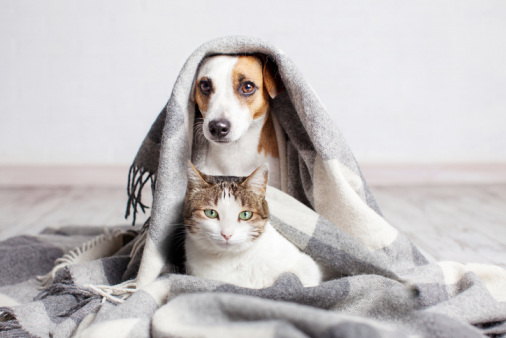The majority of Brits now turning to the internet to self-diagnose pet illnesses in a bid to cut costs

Authored by RSA
- Over half (56%) of British pet owners admit that they would rather diagnose their pet’s illness online than visit the vet, as the average cost of a vet bill for dogs is £988.13*
- Research from MORE THAN pet insurance finds 4 in 5 (80%) of pet owners end up visiting the vet anyway when online diagnoses fall short
- MORE THAN’s in-house vet Luke Mangion provides his top tips for pet owners looking to save money whilst keeping their pet’s health and wellbeing in check
As personal finances continue to be squeezed, new research today reveals how this is impacting the nation’s pets, with MORE THAN insurance finding that more than half (56%) of pet owners prefer to head online to diagnose their pets’ ailments, instead of contacting a vet.
This new study of over 1,000 dog and cat owners reveals that more than one in four (27%) are finding vet bills too expensive, and with nearly one in six (16%) believing an internet search offers the same advice as a vet. And, while there’s a wealth of expert information on vet websites and online vet services, some pet owners are instead turning to other options such as online forums (14%) and social media (9%).
The most common symptoms that pet owners try to diagnose themselves are vomiting (24%), diarrhoea (22%), and appetite changes (19%). However, while opting for an online search and some over-the-counter remedies to respond to symptoms such as these may save time and money in the short term, the result is that four in five (80%) pet owners end up visiting the vet regardless, when the initial treatment doesn’t work, and shelling out more than originally planned.
Luke Mangion, veterinary surgeon at MORE THAN, adds:
“The internet can be such a useful resource in helping pet owners understand their pet’s health. However, when using the internet to research any concerns you have around your pet’s health, it’s important to ensure you’re visiting a trusted source, that you are not relying on search engines or social media and most importantly that you are not self-diagnosing your pet from online information. With many vets now offering online services including advice or virtual appointments, it’s never been easier to vet your pet online.
“Not getting your pet checked by a certified vet when you first notice a change in their health and attempting to treat it at home yourself could cause the problem to worsen, potentially becoming more complicated to treat and much more expensive. When it comes to your pet’s health, it’s always better to be safe than sorry and consult a vet as soon as possible, whether that be in person or online.”
Analysis of MORE THAN’s pet claims data shows that the average cost of a vet bill for dogs is £988.13, and, for cats, is £895.18. In response, many pet owners are opting to protect themselves from these costs, with MORE THAN finding that over two in three (69%) pet owners now insure their pets.
Checks before the vets
Our pets instinctively try to hide or mask their pain, so if you do spot something troubling your pet, it is worth speaking with a vet to make sure everything is OK.
To help you spot any issues lurking, Luke Mangion, a qualified and practicing vet, offers his simple tips on some of the most common signs that something may be wrong and how to look for them.
Cats
- Eyes: Check for discharge, redness, cloudiness, closed or squinting eyelids or change in pupil size between the two eyes. Ensure their eyes are clear and bright.
- Nose: Coughing or sneezing could be a sign of various respiratory conditions. Listen out for changes in their breathing such as increased noise, rate or effort and check that there’s no excessive or discolored discharge.
- Ears: Check that ears are clean and free from excessive wax or hair and that there is no abnormal smell and no redness. The ear pinnae (the flappy part) should be free from any redness or scratches.
- Mouth: Cat’s gums and tongue should be salmon pink. Any lumps in the mouth, excessive tartar on teeth, fractured or missing teeth, bad breath, red or bleeding or pale gums, difficulty eating, or reduced appetite are all abnormal.
- Fur and skin: Haircoat should be shiny and well-kept. There should be no dandruff, no matted fur, no missing patches of hair (alopecia), and no fleas, mites or ticks. The skin should be pink with no redness, no rashes or hives, no wounds. There should be no discharge or smell, it should not be itchy and it should be free of any lumps or bumps.
- Paws: The pads of the paws should be free from any wounds or cracks; they should be soft and smooth. The nails should not be long, brittle, or broken and should be able to retract easily. If they have sharp nails and you need to trim them, ensure to only remove the very tips as their quicks can run almost the length of the nail.
- Stomach: The tummy should be soft and comfortable to feel with no vocalizing of pain (meowing or hissing).
Dogs
- Eyes: Check for discharge, ensure their eyes are clear and bright. Dogs also have third eyelids to protect their eyes, if these are drooping, this could be a sign of ill health or dehydration.
- Nose: Listen out for changes in their breathing and check that there’s no unusual discharge.
- Ears: Check that ears are clean and not red, crusty or smelly inside. Other signs of inner ear problems in your dog may include head shaking, or loss of balance.
- Mouth: Dog’s gums should be salmon pink, and teeth should be clean and white with no tartar or staining. Dental disease in dogs is common, so ensure you are cleaning your dog’s teeth with a brush or special chews regularly.
- Fur and skin: Dogs coats can become matted or fall out as a result of certain illnesses and skin can become greasy or smelly. Skin irritation can often be caused by fleas or ticks, so check for lumps and bumps on the skin which could indicate bites.
- Paws: Unusual brown staining on paws could be a sign of excessive licking or an underlying infection. Also check between toes for foreign objects such as grass seeds or splinters which could cause infection.
- Stomach: Signs of stomach issues in dogs include gurgling, stretching, loss of appetite, vomiting or diarrhoea. Dog’s stomachs are usually soft and relaxed, if your dog’s stomach becomes bloated and swollen this could be a sign of an emergency.
About RSA
With a 300-year heritage, RSA is one of the world’s leading multinational insurance groups.
Today, RSA employ around 23,000 people, serving 17 million customers in around 140 countries. While RSA's origins lie in London, RSA is a global company with businesses in both mature and emerging markets. RSA have major operations in the UK, Ireland, Scandinavia, Central and Eastern Europe, Canada, Asia, the Middle East and Latin America. youTalk-insurance sharing insurance news and video.

